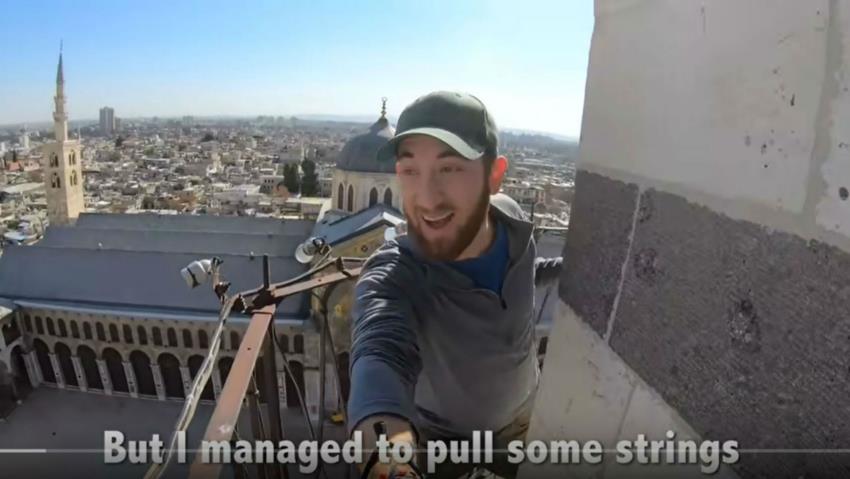“Syria, it’s not what you think,” a young Syrian woman helpfully informs us, “We have bars, entertainment stuff, everything as the western country,” echoes her friend, talking into the camera.
This tidbit comes to us via American travel YouTuber Drew Binsky’s two week Syrian adventure, which he managed to arrange after he “pulled some strings” and got permission to travel across the country.
Drew is not alone. A number of YouTubers have been flocking to the Eastern Mediterranean country: “From the very first impression, Damascus didn’t just surprise me. It astonished me. Frankly, most of us don’t know much about the city,” Eva zu Beck, a Polish vlogger with 442k YouTube subscribers tells us.
Some of these vlogs apparently intend to convey practical information for prospective travelers, such as how to get a hotel or how to hang out with Syrian girls at clubs, as one Russian YouTuber Sergey Borisov attempts to explain.
But watching them can be a jarring experience. Not only do they reveal the extent to which for some, travel is an easily accessible privilege, but they also allow a criminal regime to directly profit from the one-sided image they present.
The vloggers are on official tours of Syria, and have guides with them, all of which is prearranged through a tour operator in Damascus before entering the country. And while different YouTubers have their own takes on the countries they visit, Syria is no ordinary tourist destination.
Half a million are now dead, millions have been displaced and huge swaths of the country lie in ruins as a result of the deliberate policy choices made by the Assad regime.
The destruction of Syria was not a byproduct of the war but the intent of the war itself. Not one travel vlog explores this. The systematic destruction of the Levantine country is merely glimpsed at; just another touristic intrigue.
However, touristic intrigue does not make the visits politically neutral. While British traveler The Life of Jord is on a tour of Homs, he is informed by the guide that the city was destroyed by Islamic State (IS) and not pro-Assad forces.
Homs witnessed some of the most brutal fighting early in the war with the Assad regime placing entire neighbourhoods under siege and killing thousands, including American journalist Marie Colvin who dared to report directly from the besieged city in 2012.
In 2014, after opposition forces surrendered the city, the civilian population was forcefully expelled by the regime. Curiously the tour guide mentions none of this.
Drew Binsky’s Aleppo tour is no less political, touching upon the sensitive topic of reconstruction. “As I continued to walk around Aleppo it’s easy to tell reconstruction is in full swing… especially the parts of the city that were completely destroyed.”
Depicting the “return” to normality, with schools and businesses reopening, viewers might think the Assad regime is altruistically rebuilding the area and that locals are happy about it. But this stands in stark contrast to reports on the ground.
In fact, much of the rebuilding effort is being done by locals themselves, out of their own pocket, and with no support from the regime. Indeed, many seem to think the regime wants to keep the city in ruins as a warning to others thinking of rising up in protest. There is little doubt that travel vloggers are naively (in most cases) producing propaganda but perhaps this should come as no surprise.
It’s not only westerners but also Indians, Arabs, Russians and others who are selling Assad’s Syria to globalised, young cosmopolitan digital natives.
All of them are telling the same story that life is normal and Syria is a country like yours, minus the millions the ruling authorities decided to displace.
Syrians who try to head back to the country face the possibility of arrest or disappearance, meanwhile a 22-year old social media personality from Canada can openly travel across the country and tell their legions of followers that everything they know about Syria is wrong.
Dictatorships work because of the faux image of order and stability they project. Today, it’s interesting to note how the YouTuber is playing a role that some war reporters once did.
Seven years ago, accompanied by Syrian soldiers, Robert Fisk would appear in regime-held Damascus neighbourhoods to ask about how they feel about Assad. Now, the YouTuber is in town, and asking them to persuade us what a normal country Syria is. Whether it’s reporters or YouTubers, the regime approves and controls the stories they can access.
Riding in on tanks, and the sense of “being there” gives these reporters a special status among journalists, but the accounts they offer are no less voyeuristic than the YouTubers of today.
The Syrian regime has long used online propaganda including conspiracy chat rooms and social media personalities to further its agenda. But these YouTube influencers offer something different. By not directly engaging in politics, and framing their accounts within a global, liberal, cosmopolitan framework, they present Assad’s Syria as something “normal” and “cool”, and contribute to the rehabilitation of a violent regime.
The Syrian Observer has not verified the content of this story. Responsibility for the information and views set out in this article lies entirely with the author.


